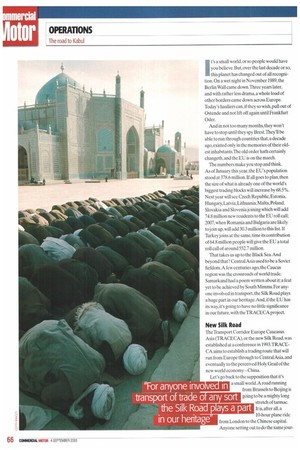ON THE ROAD TO CHANGE
Page 67

Page 66

If you've noticed an error in this article please click here to report it so we can fix it.
It's 10 years since the route from Europe to Asia was established to
aid world commerce. To test it, CM is going to take an Adios full of aid
supplies from Brussels to Afghanistan.
It's a small world, or so people would have you believe. But, over the last decade or so, this planet has changed out of all recognition. On a wet night in November 1989, the Berlin Wall came down.Three years later, and with rather less drama, a whole load of other borders came down across Europe. Today's hauliers can, if they so wish, pull out of Ostende and not lift off again until Frankfurt Oder, And in not too many months, they won't have to stop until they spy Brest.They'll be able to run through countries that, a decade ago, existed only in the memories of their oldest inhabitants. The old order hath certainly changeth, and the EU is on the march.
The numbers make you stop and think. As of January this year,the EU's population stood at 378.6 million. If all goes to plan,then the size of what is already one of the world's biggest trading blocks will increase by 68.5%. Next year will see Czech Republic, Estonia, Hungary, Latvia, Lithuania,Malta, Poland, Slovakia and Slovenia joining which will add 74.8 million new residents to the EU roll call; 2007, when Romania and Bulgaria are likely to join up, will add 30.3 million to this list. If Turkey joins at the same, time its contribution of 648 million people will give the EU a total roll call of around 552.7 million.
That takes us up to the Black Sea.And beyond that? CentralAsia used to be a Soviet fiefdom.A few centuries ago, the Caucus region was the crossroads of world trade. Samarkand had a poem written about it; a feat yet to be achieved by South Mimms. For anyone involved in transport, the Silk Road plays a huge part in our heritage. And, if the EU has its way, it's going to have no little significance in our future, with the TRACECA project.
New Silk Road
The Transport Corridor Europe Caucasus Asia (TRACECA), or the new Silk Road, was established at a conference in 1993.TRACECA aims to establish a trading route that will run from Europe through to Central Asia, and eventually to the perceived Holy Grail of the new world economy — China.
Let's go back to the supposition that it's a small world.A road running from Brussels to Beijing is going to be a mighty long stretch of tarmac. It is, after all, a 10-hour plane ride from London to the Chinese capital. Anyone setting out to do the same jour
the Silk Roa pays a part
ney by truck is probably going to need to pack a change of clothes.
But transport is what economists term a 'derived demand' There is no value to a truck until someone asks you to put something on its back.The demand for transport reflects the level of demand in the economy as a whole, and the countries signed up to the TRACECA project are in much the same position as the Middle East was three decades ago. They have something we want — oil.We have something they want — consumer goods.When buyer and seller meet, a marketplace forms and there is a demand for transport, he it pipeline, phone line or commercial vehicle.
Nowadays, with less than 10% of UK-registered trucks getting their tyres dusty on foreign soil, British hauliers may feel slightly miffed at the prospect of an initiative that will serve to improve the access of foreign — and cheaper — transport solutions to what they have seen as their own market.Ten years ago, asthmatic eastern European registered trucks were an exotic sight on our motorways. Increasingly, the numberplates one sees arc not just from Poland.Slovakia and Uzbekistan. Azerbaijani and Georgian-registered machinery is an increasingly common sight. In other words, TRACECA is already here — transport is viewed as a commodity element in the supply chain, and is bought at the cheapest rate possible. What we need to know is the effect, both short and long term.Three decades ago, opening up a whole new marketplace that had money to spend and didn't want to wait gave European hauliers the opportunity to clean up. Then the Middle East got its shipping sorted out, did its infrastructure, and things settled down. Will TRACECA, designed to open up these new markets to European industry, actually serve the European haulier, or function merely as another nail in an already well secured coffin lid? One way to find out is to wait and see.Another is to go and see. And so, next week. Commercial Motor will present a tilt stuffed with aid supplies to a Customs man in Brussels. He will, we hope, plumb us up, and wave us off. With a fair wind and a following breeze, we'll crack that seal three or four weeks later on the Afghan border.
Ancient trading routes
En mute, our Mercedes-Benz Actros will travel across two recent war zones — former Yugoslavia and Afghanistan. We will drive ancient trading routes and modern highways. We'll cross two seas, a number of deserts, and a particularly alarming-looking bridge. And, hopefully, by the end of the job, we'll have some idea as to where the whole TRACECA exercise is going to lead. While the Berlin Wall was coming down, the American satirist and commentator PJ O'Rourke suggested that it wasn't so much the presence of a whole pile of nuclear ordinance that had caused the bricks to fall as the availability of the Sony Walkman.Trade changes things. On the one hand, our world as people is getting smaller. On the other, our world as transport people is getting bigger.This may or may not be a good thing.
















































































































































































































